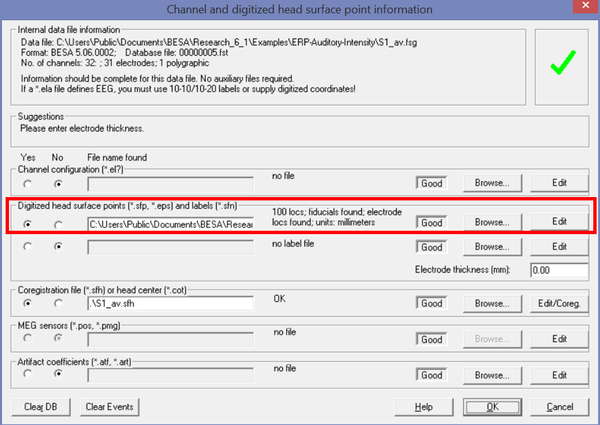Difference between revisions of "Importing Digitized Coordinates"
(→How do I check the result) |
m |
||
| (2 intermediate revisions by the same user not shown) | |||
| Line 2: | Line 2: | ||
|title = Module information | |title = Module information | ||
|module = BESA Research Basic or higher | |module = BESA Research Basic or higher | ||
| − | |version = 5.2 or higher | + | |version = BESA Research 5.2 or higher |
}} | }} | ||
== How do I import digitized electrode coordinates and head surface points == | == How do I import digitized electrode coordinates and head surface points == | ||
| − | Digitized electrode locations can be provided in a surface point file (extension *.sfp) in ASCII format. It is recommended that the first three digitized coordinates are the fiducials (fiduciary points), labeled | + | Digitized electrode locations can be provided in a surface point file (extension '''*.sfp''') in ASCII format. It is recommended that the first three digitized coordinates are the fiducials (fiduciary points), labeled '''FidNz''', '''FidT9''', '''FidT10''', followed by electrodes, and possibly additional skin points. A detailed description of the file and how to import it is given in the BESA help files (chapter: [[Electrodes_and_Surface_Locations|Working with Electrodes and Surface Locations]]). |
| + | |||
An example sfp file could look like this: | An example sfp file could look like this: | ||
| − | < | + | <source lang="dos" highlight="1-3"> |
FidNz -10.89 0.04 -4.30 | FidNz -10.89 0.04 -4.30 | ||
| − | |||
FidT9 -0.61 -7.78 -5.24 | FidT9 -0.61 -7.78 -5.24 | ||
| − | |||
FidT10 -0.70 7.34 -5.86 | FidT10 -0.70 7.34 -5.86 | ||
| − | |||
E1 -1.52 -2.31 6.98 | E1 -1.52 -2.31 6.98 | ||
| − | |||
E2 -1.65 -7.67 2.54 | E2 -1.65 -7.67 2.54 | ||
| − | |||
E3 -4.26 -8.31 -3.86 | E3 -4.26 -8.31 -3.86 | ||
| − | |||
... | ... | ||
| − | </ | + | </source> |
| − | The file is read in using the | + | The file is read in using the '''Channel and digitized head surface point information''' dialog in menu "'''File → Head Surface Points and Sensors → Load Coordinate Files'''" (use '''CTRL-L''' key on the keyboard). |
== How do I check the result == | == How do I check the result == | ||
| − | You can check on the correct reading of the file using the | + | You can check on the correct reading of the file using the '''Surface points''' window (menu "'''File → Head Surface Points and Sensors → View'''" or '''V''' on the keyboard). |
See also the article [[Verify_Electrode_Coordinates|Verify Electrode Coordinates]]. | See also the article [[Verify_Electrode_Coordinates|Verify Electrode Coordinates]]. | ||
Latest revision as of 14:22, 5 May 2021
| Module information | |
| Modules | BESA Research Basic or higher |
| Version | BESA Research 5.2 or higher |
How do I import digitized electrode coordinates and head surface points
Digitized electrode locations can be provided in a surface point file (extension *.sfp) in ASCII format. It is recommended that the first three digitized coordinates are the fiducials (fiduciary points), labeled FidNz, FidT9, FidT10, followed by electrodes, and possibly additional skin points. A detailed description of the file and how to import it is given in the BESA help files (chapter: Working with Electrodes and Surface Locations).
An example sfp file could look like this:
FidNz -10.89 0.04 -4.30FidT9 -0.61 -7.78 -5.24FidT10 -0.70 7.34 -5.86E1 -1.52 -2.31 6.98 E2 -1.65 -7.67 2.54 E3 -4.26 -8.31 -3.86 ...
The file is read in using the Channel and digitized head surface point information dialog in menu "File → Head Surface Points and Sensors → Load Coordinate Files" (use CTRL-L key on the keyboard).
How do I check the result
You can check on the correct reading of the file using the Surface points window (menu "File → Head Surface Points and Sensors → View" or V on the keyboard).
See also the article Verify Electrode Coordinates.
